Products
Products
Calibration standards
Hellma's liquid and glass calibration filters are designed for testing spectrophotometers. The company has announced accreditation for the calibration standards according to DIN EN ISO 17025. According to the company, the accreditation ensures the traceability of calibrations carried out to references of NIST, by which an international correlation of measurement results is enabled and laboratory procedures gain greater transparency and improved protection of measurement results.
Hellma USA, Inc., Plainview, NY;

UV–vis spectrophotometer
Agilent Technologies' model 8453 UV–vis spectrophotometer uses a photodiode-array detector to make measurements throughout the 190–1100 nm wavelength range. Measurements reportedly are completed in less than 1 s. The system is coupled with the company's UV-Visible Chemstation software for data analysis, data archival, and compliance with pharmacopoeia requirements and good laboratory practices.
Agilent Technologies, Inc., Santa Clara, CA;
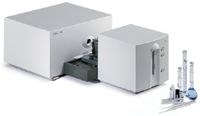
High-speed spectrometers
The AvaSpec FAST spectrometers from Avantes are designed for high-speed uses such as pulsed-laser applications in the UV-vis and NIR wavelength ranges (200–1100 nm). The F-Series is available in four standard configurations, ranging from 0.2-ms to 0.85-ms minimal integration time. The spectrometers are configured in continuous run mode in which a single external trigger results in a continuous scan of spectra up to a user-defined number of scans; they can also be configured in single-scan mode.
Avantes, Inc., Broomfield, CO;

Laser diode module
The LaserBoxx laser diode module from Oxxius has a size of 40 × 40 × 100 mm and is available at 375-, 405-, 445-, 488-, and 640-nm wavelengths at output power of up to 130 mW in circular or elliptical beams. Other reported features include power stability of <2% over 8 h, noise of <0.5% rms from 10 Hz to 2 MHz, TTL modulation of <10 ns rise/fall times, analog modulation of >2 MHz at -3 dB, and analog, USB, and RS232 control interfaces. Applications include OEM integration or laboratory use in flow cytometry, confocal microscopy, and other research or industrial uses.
Oxxius, Lannion, France;

Air sampling device
The Aerosol-to-Liquid Particle Extraction System (ALPXS) from Meinhard Glass is a portable device designed for electrostatic collection of particulates into a continuous flow of water over a stainless steel collection electrode. The collected particulates can then be analyzed by ICP-OES or ICP-MS. According to the company, the volumetric air flow is approximately 300 L/min, which provides a collection efficiency of >90% for particles <3 μm in diameter. An optional 12-V battery pack is designed to provide more than 8 h of sampling time.
Meinhard Glass Products,
Golden, CO; www.meinhard.com

UV–vis spectrophotometer
The BioSpec-nano UV–vis spectrophotometer from Shimadzu Scientific Instruments is designed to be a dedicated spectrophotometer for the quantitation of nucleic acids and protein analysis. An automated drive mechanism reportedly ensures accurate and reproducible results. According to the company, the spectrophotometer requires 1 μL of sample with a 0.2-mm pathlength or 2 μL with a 0.7-mm pathlength, which is pipetted onto a measurement plate. An optional rectangular cell adapter is available for applications that are not volume limited. Sample measurement time reportedly is 3 s. Dedicated software is included for instrument operation.
Shimadzu Scientific Instruments, Columbia, MD;
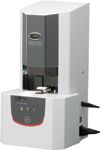
X-ray source
The 40-kV Magnum Reflection X-ray source from Moxtek is designed to be a high output, low-power-consumption device capable of delivering a flux of 2 × 1011 photons/s/steradian/0.10 μA into a large solid angle of 45° at the full width half maximum. The source reportedly provides a focal spot of 300 μm and high energy concentration in the characteristic lines for applications such as high-resolution contrast imaging, quantitative XRF, and qualitative XRD. The source has a reported maximum high voltage potential of 40 kV, a beam current of 0.10 mA, and total power of 4 W. The source operates on an input voltage of 7–10 V dc with a maximum power consumption of 7 W, according to the company.
Moxtek Inc., Orem, UT;

Custom standards
Customized low-level inorganic and organic certified reference materials from SPEX CertiPrep are designed for customers looking for a specific mix of analytes in ppb-level concentrations. The company reportedly manufactures and analyzes all custom mixtures in its cleanroom facilities and is ISO 9001 certified and accredited by A2LA as complying with the requirements of ISO/IEC 17025:2005 and ISO/IEC Guide 34-2000.
SPEX CertiPrep, Metuchen, NJ;

ICP-MS system
The NexION 300 ICP-MS system from PerkinElmer is designed for parts-per-trillion detection of trace elements for diverse applications. According to the company, the system reduces the need for daily user maintenance and cleaning. The instrument reportedly provides three modes of interference removal: Standard, Collision, and Reaction. The modes are designed for simple, routine analyses, semiquantitative analyses, and analyses of difficult elements and matrices, respectively.
PerkinElmer, Inc., Waltham, MA;
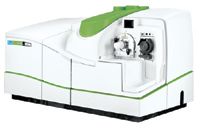
Cryogenic mill
The model 6870 Freezer/Mill cryogenic mill from SPEX SamplePrep is designed for samples that are considered difficult or impossible to grind at normal room temperature. The large-capacity mill is available with an auto-fill system that automatically maintains the required level of liquid nitrogen within the mill during operation. The auto-fill system is available as an option that can be factory installed or as a factory retrofit package for systems already in service.
SPEX SamplePrep, Metuchen, NJ;
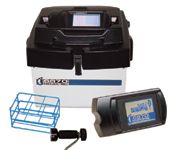
Confocal mapping FLIM system
HORIBA Scientific's DynaMyc microfluorescence dynamics mapping system is designed to provide information about molecular motion, sizes, local environment, interaction, and binding, with discrimination to microscopic locations in the sample. According to the company, the system generates lifetime images more than 20 times faster and can capture complete fluorescence lifetime images in minutes. The system reportedly offers a range of interchangeable excitation wavelengths to match user labels.
HORIBA Scientific, Edison, NJ;

Raman systems
The ProRaman-L systems from Enwave Optronics are designed for high-sensitivity industrial and laboratory Raman applications. The systems feature a 785-nm frequency-stabilized laser, a spectrograph with cooled CCD options from -50 °C to -70 °C, and a high-throughput laboratory fiber-optic probe. The systems reportedly achieve approximately 4.5 cm-1 average optical resolution with various ranges of spectral coverage: ~250–2350 cm-1, ~100–2200 cm-1, and ~100–3300 cm-1. The systems' laser power is ~300–400 mW, with higher output power available upon request.
Enwave Optronics, Inc., Irvine, CA;

Fluorescence spectrometer
The Lumina dual-monochromator scanning fluorescence spectrometer is designed for both research applications and routine laboratory analyses. The instrument reportedly provides a 0.5-nm spectral bandwidth, a scanning speed of up to 6000 nm/min, and slewing at 20,000 nm/min. The spectrometer's photomultiplier detector reportedly provides measurement of the NIR wavelengths (190–900 nm) for biochemistry and photosynthesis applications.
Thermo Fisher Scientific Inc., Madison, WI;

Silicon drift detector
The Super SDD silicon drift detector from Amptek is designed for high count rate applications in handheld systems and bench-top analyzers. The X-ray detector, preamplifier, and cooler system reportedly are thermoelectrically cooled. The input FET and a feedback circuit are mounted on the detector's two-stage cooler and are kept at approximately -55 °C. According to the company, the 25 mm2 × 500 μm detector provides an FWHM resolution of 127 eV, a peaking time of 11.2 μs, and a peak-to-background ratio of 8000.
Amptek Inc., Bedford, MA;

Mid-IR hollow waveguide accessory
The FlexIR mid-IR hollow waveguide accessory from PIKE Technologies is designed for remote FT-IR sampling. According to the company, the benefits of the hollow waveguides include flexibility, durability, and the capability to cover the mid-IR spectral range with a single probe. ATR, specular, and diffuse reflectance probes are available. Applications include the FT-IR measurement of samples that are not conducive to in-compartment sampling due to physical size or chemical properties and for in-situ IR testing. According to the company, the accessory is compatible with most FT-IR spectrometers.
PIKE Technologies, Madison, WI;

Double-beam sample compartment
A double-beam sample compartment for Pair Technologies' Pair2 100 Series PA-IR spectrometers enables users to perform analyses with a double-beam system. According to the company, advantages include elimination of the need for purging by cancelling water vapor and carbon dioxide interferences, and the ability to measure very small differences between materials by placing one in the reference beam and the other in the sample beam. Also, the double-beam system allows two polarizers to be used simultaneously.
Pair Technologies, LLC, Newark, DE;

Spectroelectrochemical transmission cell
A thin-layer, optically transparent electrode transmission cell from Specac is designed for in-situ FT-IR spectroelectrochemical analysis at temperatures ranging from -50 °C to 70 °C. The demountable cell has a modular design that reportedly fits a range of sample holders. The cell comprises two calcium fluoride windows separated by a 100- or 200-μm sample layer, with gold working and counter electrodes imprinted on the cell window. The air-tight cell has a sample volume of 0.3–0.6 mL and can be used in an evacuated environment.
Specac, Inc., Cranston, RI;

EDXRF spectrometer
The S2 Ranger energy dispersive X-ray fluorescence (EDXRF) spectrometer from Bruker AXS includes the company's maintenance-free Xflash LE silicon drift detector. The spectrometer has an excitation power of 50 W. The instrument reportedly can measure light elements such as sodium and magnesium.
Bruker AXS Inc., Madison, WI;

Ratio beam spectrophotometer
The U-5100 ratio beam spectrophotometer from Hitachi is designed for applications ranging from teaching to routine QC, biotech, and environmental testing. The system has a wavelength range of 190–1100 nm, a spectral bandwidth of 5 nm, and LCD screen dimensions of 120 mm × 90 mm. According to the company, it can perform photometry, wavelength scan, time scan, and absorbance ratio measurements. The spectrophotometer includes a six-position automatic cell changer.
Hitachi High Technologies America, Inc., Pleasanton, CA;
www.hitachi-hta.com/spectroscopy
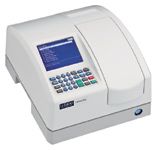
Raman microscope
Renishaw's inVia Raman microscope can be used for nondestructive testing of sperm DNA for assessing the healthiness of sperm cells. The instrument can be customized to integrate optical tweezing, which enables researchers to immobilize sperm cells with a tightly focused laser beam. The resulting Raman spectra contain information about the vibrations of molecules within the sperm cells and can be used to assess the state of its DNA.
Renishaw, Hoffman Estates, IL;

Raman system for inverted microscopy
The XploRA INV compact analytical Ramam chemical imaging microscope from HORIBA Scientific reportedly combines the automatization features and small footprint of a standard confocal Raman microscope with the capabilities of an inverted microscope for biological applications such as cell research, cancer detection, pharmaceutical verification of intercellular activities, inclusion of microreactors, and incorporation of AFM units for tip-enhanced Raman spectroscopy. According to the company, the microscope's open structure permits the use of options and add-ons for inverted microscopes, such as micromanipulators, "optical tweezers," and specific enclosures for cell applications.
HORIBA Scientific, Edison, NJ;

UV-vis spectrophotometer
The Evolution Array UV-vis spectrophotometer from Thermo Fisher Scientific is designed with a photodiode array for fast acquisition of full-spectrum UV-vis data in QA/QC, pharmaceutical, life science, materials science, and educational laboratories. The spectrophotometer reportedly provides simultaneous detection of all UV-vis wavelengths in the 190–1100 nm region. According to the company, users can create standard curves, plot 3D graphical displays, and examine samples at any wavelength at any time. A mechanical shutter reportedly is the only moving part.
Thermo Fisher Scientific, Waltham, MA;
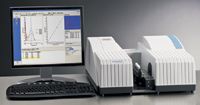
Mercury analyzer
The model RA-3000 Gold+AFS mercury analyzer from Nippon Instruments is designed for EPA Method 1631E. According to the company, the analyzer simplifies low- to sub-parts-per-million mercury analysis and reduces reagent consumption and wastes.
Nippon Instruments North America, College Station, TX;

Miniature chemical detector
1st Detect's Miniature Chemical Detector is an ion-trap mass spectrometer designed for field-portable and handheld applications. The instrument, which weighs less than 15 lb, has a mass range of 10–450 amu, a resolution of less than 1 amu, and an analysis time of less than 2 s. Possible applications include industrial process control, security and defense, first response and critical infrastructure analyses, and medical analyses such as point-of-care diagnostics or proteomics. The instrument can be powered by 120/240 VAC, standard UBI-2590 batteries, or by standard 12/24 VDC vehicle power.
1st Detect, Austin, TX;

Raman microscopes
The alpha300 microscopes from WITec are designed for Raman analyses. The alpha300 M microscope is intended for single-point spectrum acquisitions and depth profiling. The alpha300 M+ includes a stepper motor and reportedly allows mapping experiments and large-area investigations. The stepper motor also can be attached to the alpha300 R imaging system. The alpha300 ML features high-resolution confocal Raman mapping. Upgrades and combinations with atomic force or scanning near-field optical microscopy are available.
WITec GmbH, Ulm, Germany;

Mercury analysis application note
An application note from Teledyne Leeman Labs describes the analysis of mercury in cosmetics using a direct mercury analyzer. The note discusses the use of the company's Hydra-C direct mercury analyzer to analyze the cosmetic materials without sample pretreatment or production of hazardous chemical waste. According to the note, the analysis requires 5–10 min and eliminates the need for the chemical digestion step required by other approaches.
Teledyne Leeman Labs, Hudson, NH;

Benchtop LIBS elemental analyzer
The Insight benchtop LIBS system from Photon Machines is designed for quick, accurate elemental analysis, including the analysis of light elements such as B, Be, Li, and C that are difficult to measure using methods such as XRF. The system can be used for applications such as trace analysis, mineral quantification, and metal alloy analysis. On-board video enables on-sample targeting and building of analysis programs. Software-adjustable spot sizes can be varied from 5 μm to 2 mm. Custom systems are available.
Photon Machines, Inc., Redmond, WA;

Surface-enhanced Raman products
The Chemical Residue Detector is a handheld SERS analyzer. According to the company, it is capable of detecting trace chemicals in the lab or the field. Samples are reportedly collected in SERS-active capillaries or vials, and chemicals in liquids or residues on surfaces such as drugs, explosives, pesticides, and food or water contaminants are then identified. The SERS capillaries are used to collect liquid samples using a syringe. The 96-well SERS-active plates are designed to enable screening of samples.
Real-Time Analyzers, Inc., Middletown, CT;

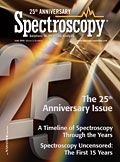
Getting accurate IR spectra on monolayer of molecules
April 18th 2024Creating uniform and repeatable monolayers is incredibly important for both scientific pursuits as well as the manufacturing of products in semiconductor, biotechnology, and. other industries. However, measuring monolayers and functionalized surfaces directly is. difficult, and many rely on a variety of characterization techniques that when used together can provide some degree of confidence. By combining non-contact atomic force microscopy (AFM) and IR spectroscopy, IR PiFM provides sensitive and accurate analysis of sub-monolayer of molecules without the concern of tip-sample cross contamination. Dr. Sung Park, Molecular Vista, joined Spectroscopy to provide insights on how IR PiFM can acquire IR signature of monolayer films due to its unique implementation.
Deep Level Transient Spectroscopy Reveals Influence of Defects on 2D Semiconductor Devices
April 25th 2024A recent study used deep level transient spectroscopy to investigate the electrical response of defect filling and emission in monolayer metal-organic chemical vapor deposition (MOCVD)-grown materials deposited on complementary metal-oxide-semiconductor (CMOS)-compatible substrates.